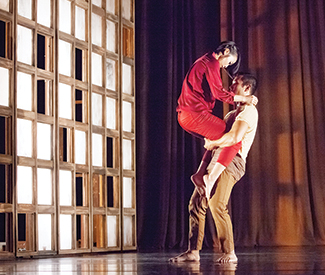arts@sfbg.com
DANCE
“She started right away on the collaborative process. I have this wonderful image of the Bryant Street studio. There was no real mirror, only one leaning against the wall. I remember Margy sitting with her back against it — I was afraid that it might fall on her — and her saying, ‘I have so many ideas in my head that I am afraid I can’t all get them out.’ What I really liked was that she also was interested in the ideas in my head, and she wasn’t going to impose her ideas, and this was going to be a conversation.” — Ginny Matthews, Margaret Jenkins Dance Company, 1974-1980
That’s how one of the country’s most remarkably individual companies was born. After moving back to her hometown in 1970 at a time when San Francisco was barely a dot on the map in terms of modern and postmodern dance, Margaret Jenkins has created over 75 works. Now 70, she has just renewed the lease on her spacious Margaret Jenkins Dance Lab studio on Eighth Street for another five years. CHIME, Jenkins’ mentorship program for professional dancers, is a wild success locally and in Los Angeles.
In 2006, she took her conversation global, collaborating with India’s Tansuree Shankar Dance Company on A Slipping Glance; in 2009, she created Other Suns with China’s Guangdong Modern Dance Company. And she is still at it, intrigued by questions that pop up in discussions with her again and again: “Wouldn’t be interesting if…”
As the light streams in through the studio’s floor-to-ceiling windows on this March afternoon, Jenkins is watching 15 dancers, seven of her own and eight from the Jerusalem-based Kolben Dance Company. They have just taken a break from rehearsing The Gate of Winds, which came about after Jenkins traveled to Jerusalem, a city she had always wanted to visit. “Having been raised in a progressive Jewish family, and as an atheist, I was curious what it would feel like putting my feet on the ground,” she observed.
She is aware that she and Kolben’s artistic director, Amir Kolben, have quite different approaches to the creative process. But working with his dancers in Jerusalem, she found them “fierce and wonderful movers.” Kolben, who had never worked with a collaborator before, was intrigued “more with the way we think than with how we create,” he explains.
Jenkins seems pleased with what she has just witnessed: two beautifully trained groups of performers who are stretching themselves emotionally and physically in exploring paths that they may not even know to have existed.
“Margy is very brave. She has an intellectual honesty about her that I really appreciated and [that she] communicated with me. I was doing solo work, and it was a very difficult time for me, and I learned to trust myself. [Being with the company] buoyed me up in so many different ways. Besides, it was nice to be on stage with others.” — Rinde Eckert, MJDC, 1987-1995
Still, Jenkins seems to have just a touch of melancholy about her when she looks forward and backward. Will she renew her lease again five years? “All too often, I ask myself whether there will be any money,” she sighs. “Every year, I start from absolute zero.”
Perhaps it was some of those thoughts that gave rise to the second piece on this 40th anniversary bill. For Times Bones, which premiered at the University of Maryland last September, Jenkins took a look at her past repertoire — at least the 68 pieces of which video exists — to see whether there were “untold stories” in them. She was struck by “how little contact the dancers had with each other. Now they partner each other. I have no idea why that’s the case.” This became another “wouldn’t it be interesting…” question. She had her present company learn fragments of pieces she had chosen, and then told the dancers to have their own conversations with them.
“I found her democratic process, her way of giving everyone voice in the process, to be infuriating and enlightening all at the same time. I hated the idea that she didn’t tell us what to do. It wasn’t enough to make movement that got you from here to there; it had to be thoroughly investigated. We were constantly throwing out anything that felt familiar or ‘already been done before.’ And the enlightening part was her willingness to let divergent types of material exist together. I still use this idea of colliding materials together, in an effort to surprise my original conception of things.” — Joe Goode, MJDC, 1980-1984 *
MARGARET JENKINS DANCE COMPANY
Thu/3-Sat/5, 7:30pm; Sun/6, 3pm, $30-35
Yerba Buena Center for the Arts
701 Mission, SF

